Hearing into George Pell’s sexual abuse convictions begins
After three months behind bars, George Pell emerged, back in black and with his collar on, looking as determined and confident as he has since he first returned to Australia to face historical child sex crime allegations.
Law & Order
Don't miss out on the headlines from Law & Order. Followed categories will be added to My News.
Cardinal George Pell’s legal team has claimed there are 13 key reasons why a jury was wrong to convict him of child-sex crimes.
Pell is serving a six-year jail term, handed down in March, for the sexual assaults of two choirboys in 1996.
He returned to court on Wednesday, seeking leave to appeal the convictions. If he fails, he must serve at least another 3½ years behind bars before becoming eligible for parole.
His bid to have the convictions quashed is being led by appeals expert Bret Walker, SC, who claimed three main grounds to free Pell.
He spent more than five hours articulating his key argument, that the jury’s verdicts were unreasonable when all of the evidence was properly considered.
The jury could not have been satisfied beyond reasonable doubt that Pell was guilty, he said.
The second ground was that the trial judge erred in not allowing a 19-minute video, which would have revealed the offending to have been impossible, to be shown in court.
The third ground was a “fundamental irregularity” in the trial, in that Pell did not plead guilty or not guilty before the jury, as required.

Pell was found guilty in December of molesting two St Patrick’s Cathedral choirboys, one on two separate occasions, months after being appointed Archbishop of Melbourne.
The guilty verdicts came at the end of a retrial after an original jury was unable to reach a majority verdict.
But Mr Walker maintained to the Court of Appeal on Wednesday that there were “13 solid obstacles in the path of a conviction”.
Mr Walker argued that the evidence at trial established such a high improbability, verging on impossibility, of Pell committing the offences that the jury must have been faced with a reasonable doubt.
Much of his attention was focused on the submission that Pell couldn’t have been in the sacristy of St Patrick’s Cathedral at the time the surviving complainant had claimed he was assaulted.
Mr Walker argued Pell would have been outside church greeting congregants after Mass, therefore could not have possibly been in the sacristy abusing choirboys.
Pell listening intently. He’s one of the few people in the room who hasn’t, at least for a fleeting moment, become distracted by something else. Of course, he is the only person in the room who will spend at least another 3.5 years behind bars if this doesn’t go his way.
— Shannon Deery (@s_deery) June 5, 2019
He said trial prosecutors failed to challenge credible evidence that raised serious doubts about Pell’s ability to have committed the offences.
He also pointed to the absence of key witnesses, including the second victim and another priest who both died several years ago.
Mr Walker has referred to both the second and third grounds of his argument as “fallback” grounds should the first ground fail.
Chief Justice Anne Ferguson, Court of Appeal president Justice Chris Maxwell and Justice Mark Weinberg are presiding.
Ahead of the hearing, they each read submissions from both sides and reviewed other evidence including recordings, transcripts, photographs, robes and documents.
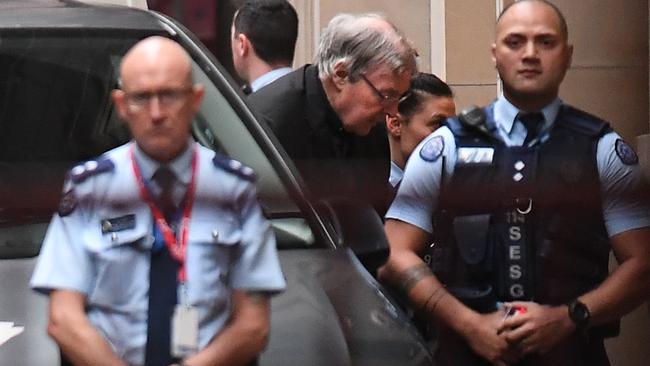
“We are quite familiar with the evidence and the arguments that are to be made,” said Chief Justice Ferguson.
In their submissions, prosecutors have argued the integrity of the jury’s verdicts is unimpeachable. “The evidence given by the complainant was not only plausible, it was credible, clear and entirely believable, as is reflected in the jury’s verdict,” they argue.
“Any inconsistencies in the complainant’s evidence were of little moment and could not have been said to have impacted on his credibility in any material way,” they said.
The hearing continues.
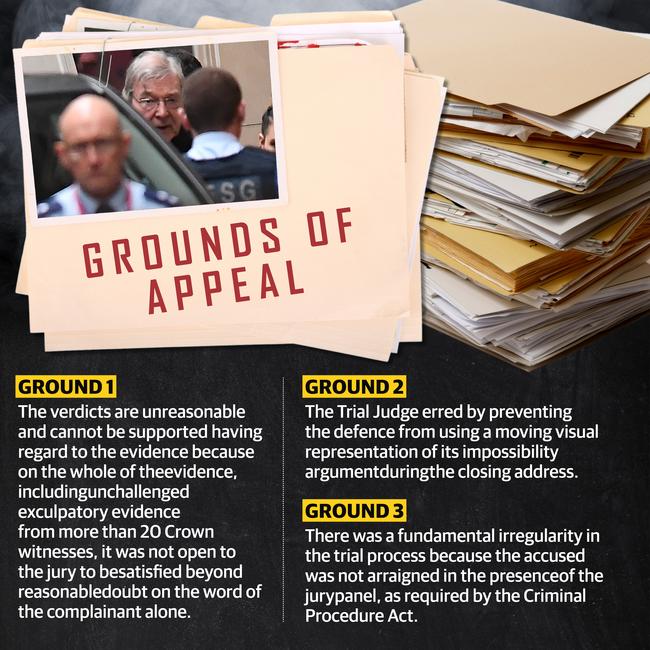
HOW THE APPEAL WILL PLAY OUT
What Pell’s defence team will argue, and how the prosecution will rebut it
INCIDENT 1
Pell convicted of four charges over the sexual assault of two choirboys in the sacristy of St Patrick’s Cathedral following a Sunday Solemn Mass in 1996. Pell, still wearing his archbishop’s robes, found the boys swigging altar wine after running away from the choir.
DEFENCE 1 The alleged offences did not or could not have occurred because of a range of logistical impossibilities.
PROSECUTION 1 The jury reached the right verdict based on world experience and common sense and that conclusion is unimpeachable.
D2 The timing of the alleged assaults was impossible given the complainant insisted that the two offences occurred in late 1996, but the jury reached a verdict based on the later offence taking place in 1997.
P2 The complainant did not “insist” that both incidents occurred in 1996, but suggested that was the likely time period.
D3 It was not possible for Pell to be alone in the sacristies only a few minutes after the end of Mass because he spent time meeting congregants on the steps of the cathedral.
P3 The evidence was that the so-called “meet and greet” did not always occur and that there would be occasions when the applicant did not spend time on the steps.
D4 It was not possible for Pell to be robed and alone in the priests’ sacristy after Mass in part because of a church convention that stipulated robed bishops were never to be left alone.
P4 The centuries-old protocol did not preclude that there were occasions on which the applicant as archbishop was, in fact, alone and robed, with one witness testifying he had seen Pell alone and robed.
D5 It was not possible for two choir boys to be sexually assaulted in the priests’ sacristy after Mass by Pell undetected because it would have been a hive of activity.
P5 It was not the case that the sacristy was necessarily only ever “momentarily” unattended, with testimony that proved beyond reasonable doubt that the sacristy was sometimes left open and unattended.
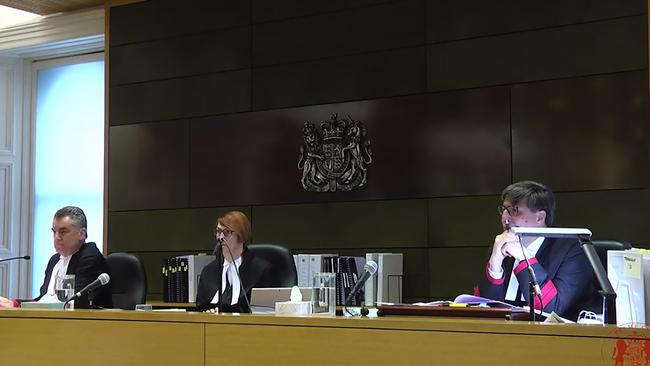
Pell’s leading lawyer, Bret Walker SC, has just sauntered into court. There’s no other word to describe it. Hands in pockets, as calm as anything. Not a worry in the world. Word is he’s fairly confident going into this.
— Shannon Deery (@s_deery) June 4, 2019
D6 It was not possible for two robed sopranos to leave an external procession without being noticed, with no choristers testifying they had ever seen such an incident.
P6 The fact that none of the choristers (most of whom were then aged between 10 and 16 years) could recall seeing two other choristers detaching from the choir was of little significance.
D7 Officials near the sacristy corridor door at the time did not see the complainant or the other boy.
P7 There was no evidence that there were any officials located at the corridor at any set time.
D8 It was impossible for the complainant and the other boy to be absent from the choir room after Mass because special choir rehearsals had taken place on the only days the offending could have happened.
P8 There was no roll call taken at the conclusion of Mass.
D9 It was not possible for the complainant and the other boy to re-enter the choir room unnoticed.
P9 The door was sometimes chocked open until choristers had moved through. Even when the door was closed, it was simply a matter of choristers pressing the buzzer to gain entry to the choir room.
D10 The crimes attributed to Pell were physically impossible because of unchallenged evidence that it was not possible to part Pell’s robes to reveal his penis in the manner described by the complainant.
P10 The complainant did not say in his evidence that the robes were “parted” to reveal Pell’s penis. The jury were afforded the opportunity to examine the items of clothing for themselves.
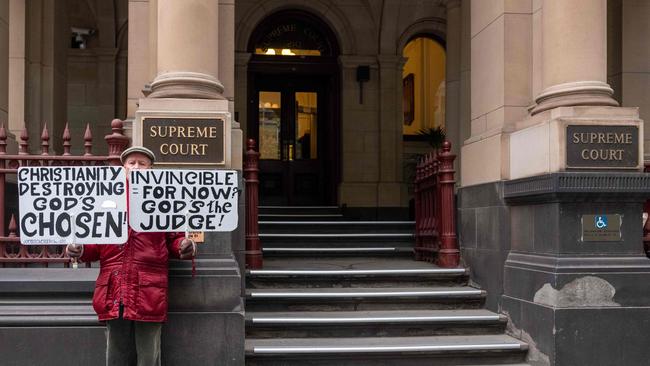
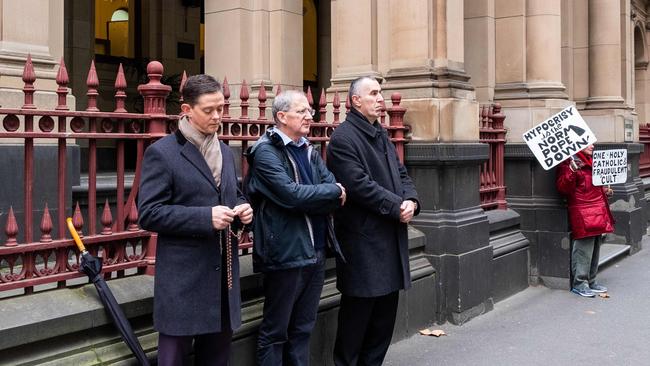
INCIDENT 2
That about a month after the first incident, Pell encountered one of the boys again in a corridor at St Patrick’s Cathedral after Mass. He pushed him against a wall and grabbed his genitals in an encounter lasting just seconds.
D11 The Crown case that the second incident occurred in 1997 was contrary to the complainant’s evidence.
P11 The complainant did not give evidence specifically that the second incident occurred in 1996.
D12 No one corroborated the second incident, though the complainant said it happened in the midst of a 50-person choir.
P12 The complainant agreed there were some people around in the hallway when it happened but did not agree that it was in view of anyone.
D13 It was not possible for Pell to be in that part of the sacristy corridor at the time of the second incident because of his practice of greeting parishioners on the cathedral steps.
P13 The evidence before the jury did not establish that Pell was always on the cathedral steps, rather this was a practice.
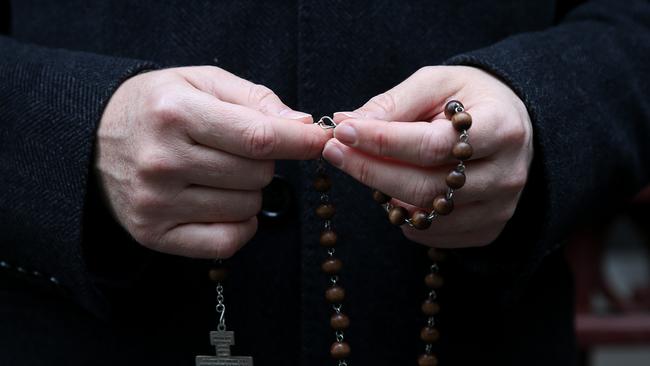
ALL EYES ON THE MAN IN BLACK
AFTER three months behind bars, George Pell emerged on Wednesday looking as determined and confident as he has since he first returned to Australia to face historical child sex crime allegations.
It was the first time he had been seen since he was sentenced in March to a six- year maximum jail term.
On that occasion, he had been stripped of his identity: the clerical collar and bishop’s ring he has worn for decades.
He looked startled, too, as if the reality of the jury’s verdict delivered in December had only just sunk in as he sat being sentenced for crimes he swears he didn’t commit.
But on Wednesday, it was the Pell that has come to be expected from a divided public: back in black, dressed in his collar, and with that knowing air of confidence about him.
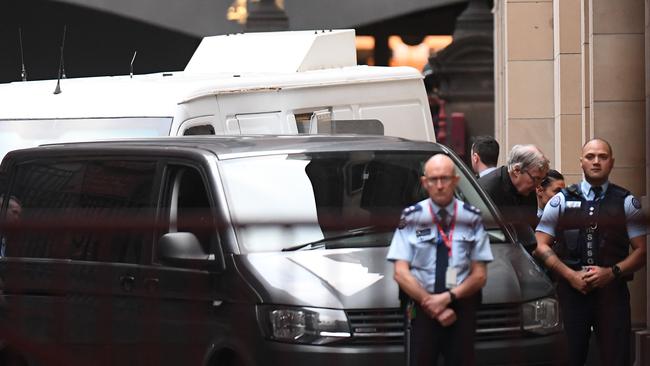
During more than five hours of legal argument, he sat in the makeshift dock of court 15 inside the Supreme Court, taking notes and listening with a fierce intensity as his legal team dissected his grounds of appeal for the appellate judges.
Not once did he waver as he followed the to and fro between his leading lawyer, Bret Walker, SC, and the appellate judges who demanded to be convinced that they should overturn a verdict of the people.
If the judges knew which way they were leaning after reviewing a considerable slab of the evidence, including a visit to St Patrick’s Cathedral and reading appeal submissions from both parties, they never once let on.
While Pell has sat confidently through dozens of other hearings — a committal and two trials — this was different.
It may have been the four high-security-prison guards that surrounded him that gave an impression of strength.
THE MAN THAT CLASHED WITH GEORGE PELL
‘SERIOUS THREAT’: PELL’S LIFE BEHIND BARS
WHAT BUGGED A PRIEST ABOUT HIS PRIVATE CALL TO PELL
His status as a maximum-security prisoner, because of fears for his safety not fears of further offending, means he is treated in the same way as Victoria’s most serious and feared criminals.
Inside the Melbourne Assessment Prison, where he has been for just over three months, he is held in 23-hour-a-day solitary confinement.
His short trip to court on Wednesday was in a van reserved just for him, and the court went into partial lockdown as he was moved through the building.
He arrived just after 9am, four hours after the first media pack arrived.
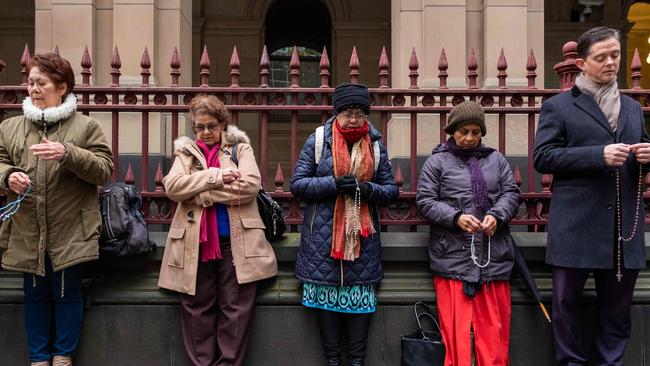
Extra security measures were also put in place ahead of Wednesday’s hearing amid serious concerns for his safety.
Some of the measures included blacking out windows inside the Supreme Court and designing a unique route for Pell to be escorted through the court.
Extra security was also on hand outside the court.
Unlike previous hearings, which saw a large crowd of supporters and protesters, only a few people gathered outside the court ahead of the hearing.
But the court, and an overflow room, was full with estimates of up to 100 people turning out to watch. It could have been more but for the court’s decision to live-stream the hearing on its website.
Sources say many senior judicial officials tuned in, with the case tipped to have significant consequences, and experts predicting a High Court appeal whichever way the current judges rule.
As always, Pell’s trusty aide, Katrina Lee, was in court, as were longtime friends, some who had travelled a significant distance to be there.
In almost two years of court hearings, he’s never had such a show of personal support, including his brother, David, and other family members.
Pell was the last to take his seat in court. When the judges come to hand down their ruling, he’ll be hoping an acquittal on all charges sees him the first to leave.
